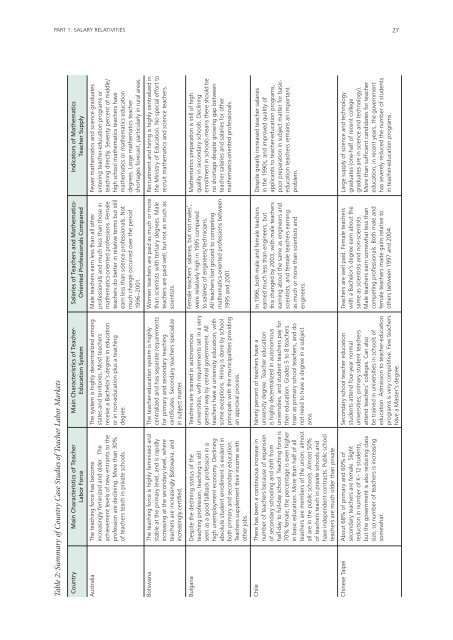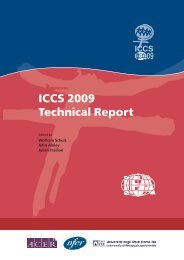Teacher Education and Development Study in Mathematics - IEA
Teacher Education and Development Study in Mathematics - IEA
Teacher Education and Development Study in Mathematics - IEA
Create successful ePaper yourself
Turn your PDF publications into a flip-book with our unique Google optimized e-Paper software.
PART 1: SALARY RELATIVITIES<br />
27<br />
Table 2: Summary of Country Case Studies of <strong>Teacher</strong> Labor Markets<br />
Country Ma<strong>in</strong> Characteristics of <strong>Teacher</strong> Ma<strong>in</strong> Characteristics of <strong>Teacher</strong>- Salaries of <strong>Teacher</strong>s <strong>and</strong> <strong>Mathematics</strong>- Indicators of <strong>Mathematics</strong><br />
Labor Force <strong>Education</strong> System Oriented Professionals Compared <strong>Teacher</strong> Supply<br />
Australia<br />
The teach<strong>in</strong>g force has become<br />
<strong>in</strong>creas<strong>in</strong>gly fem<strong>in</strong>ized <strong>and</strong> older. The<br />
achievement levels of new entrants to the<br />
profession are decl<strong>in</strong><strong>in</strong>g. More than 30%<br />
of teachers teach <strong>in</strong> private schools.<br />
The system is highly decentralized among<br />
states <strong>and</strong> territories. Most teachers<br />
receive a Bachelor’s degree <strong>in</strong> education<br />
or <strong>in</strong> non-education plus a teach<strong>in</strong>g<br />
degree.<br />
Male teachers earn less than all other<br />
professionals <strong>and</strong> much less than those <strong>in</strong><br />
mathematics-oriented professions. Female<br />
teachers do better <strong>in</strong> relative terms but still<br />
earn less than science professionals. Not<br />
much change occurred over the period<br />
1996–2001.<br />
Fewer mathematics <strong>and</strong> science graduates<br />
enter<strong>in</strong>g teacher-education programs or<br />
teach<strong>in</strong>g directly. Seventy percent of middle/<br />
high school mathematics teachers have<br />
mathematics or mathematics education<br />
degrees. Large mathematics teacher<br />
shortages forecast, particularly <strong>in</strong> rural areas.<br />
Botswana<br />
Bulgaria<br />
The teach<strong>in</strong>g force is highly fem<strong>in</strong>ized <strong>and</strong><br />
stable at the primary level, <strong>and</strong> is rapidly<br />
<strong>in</strong>creas<strong>in</strong>g at the secondary level, where<br />
teachers are <strong>in</strong>creas<strong>in</strong>gly Batswana, <strong>and</strong><br />
<strong>in</strong>creas<strong>in</strong>gly certified.<br />
Despite the decl<strong>in</strong><strong>in</strong>g status of the<br />
teach<strong>in</strong>g profession, teach<strong>in</strong>g is still<br />
seen as a good fallback profession <strong>in</strong> a<br />
high unemployment economy. Decl<strong>in</strong><strong>in</strong>g<br />
absolute student enrollment is evident <strong>in</strong><br />
both primary <strong>and</strong> secondary education.<br />
<strong>Teacher</strong>s supplement their <strong>in</strong>come with<br />
other jobs.<br />
The teacher-education system is highly<br />
centralized <strong>and</strong> has separate requirements<br />
for primary <strong>and</strong> secondary teach<strong>in</strong>g<br />
certificates. Secondary teachers specialize<br />
<strong>in</strong> subject matter.<br />
<strong>Teacher</strong>s are tra<strong>in</strong>ed <strong>in</strong> autonomous<br />
universities, with requirements set <strong>in</strong> a very<br />
general way by central government. All<br />
teachers have a university education, with<br />
some exceptions. Hir<strong>in</strong>g is done by school<br />
pr<strong>in</strong>cipals with the municipalities provid<strong>in</strong>g<br />
an approval process.<br />
Women teachers are paid as much or more<br />
than scientists with tertiary degrees. Male<br />
teachers are paid well, but not as much as<br />
scientists.<br />
Female teachers’ salaries, but not males’,<br />
were relatively high <strong>in</strong> 1995 compared<br />
to salaries of eng<strong>in</strong>eers/technicians.<br />
All teachers lost ground to compet<strong>in</strong>g<br />
mathematics-oriented professions between<br />
1995 <strong>and</strong> 2001.<br />
Recruitment <strong>and</strong> hir<strong>in</strong>g is highly centralized <strong>in</strong><br />
the M<strong>in</strong>istry of <strong>Education</strong>. No special effort to<br />
recruit mathematics <strong>and</strong> science teachers.<br />
<strong>Mathematics</strong> preparation is still of high<br />
quality <strong>in</strong> secondary schools. Decl<strong>in</strong><strong>in</strong>g<br />
enrollment <strong>in</strong> schools means there should be<br />
no shortage despite grow<strong>in</strong>g gap between<br />
teacher salaries <strong>and</strong> salaries for other<br />
mathematics-oriented professionals.<br />
Chile<br />
There has been a cont<strong>in</strong>uous <strong>in</strong>crease <strong>in</strong><br />
number of teachers because of expansion<br />
of secondary school<strong>in</strong>g <strong>and</strong> shift from<br />
half-day to full-day school. Teach<strong>in</strong>g force is<br />
70% female; the percentage is even higher<br />
<strong>in</strong> basic education. More than half of all<br />
teachers are members of the union; almost<br />
all are <strong>in</strong> the public schools. Almost 50%<br />
of teachers teach <strong>in</strong> private schools <strong>and</strong><br />
have <strong>in</strong>dependent contracts. Public school<br />
teachers are much older than private.<br />
N<strong>in</strong>ety percent of teachers have a<br />
university degree. <strong>Teacher</strong> education<br />
is highly decentralized <strong>in</strong> autonomous<br />
universities, <strong>and</strong> student teachers pay for<br />
their education. Grades 5 to 8 teachers<br />
tra<strong>in</strong> as primary school teachers, <strong>and</strong> do<br />
not need to have a degree <strong>in</strong> a subject<br />
area.<br />
In 1996, both male <strong>and</strong> female teachers<br />
earned much less than eng<strong>in</strong>eers, but<br />
this changed by 2003, with male teachers<br />
earn<strong>in</strong>g about the same as eng<strong>in</strong>eers <strong>and</strong><br />
scientists, <strong>and</strong> female teachers earn<strong>in</strong>g<br />
as much or more than scientists <strong>and</strong><br />
eng<strong>in</strong>eers.<br />
Despite greatly <strong>in</strong>creased teacher salaries<br />
<strong>in</strong> the 1990s, <strong>and</strong> improved quality of<br />
applicants to teacher-education programs,<br />
poor preparation <strong>in</strong> subject matter for basiceducation<br />
teachers rema<strong>in</strong>s an important<br />
problem.<br />
Ch<strong>in</strong>ese Taipei About 68% of primary <strong>and</strong> 60% of<br />
secondary teachers are female. Slight<br />
reduction <strong>in</strong> number of K–12 students,<br />
but the government is also reduc<strong>in</strong>g class<br />
size, so number of teachers is <strong>in</strong>creas<strong>in</strong>g<br />
somewhat.<br />
Secondary school teacher education<br />
students attend four-year normal<br />
universities; primary student teachers<br />
attend teachers’ colleges. Can also<br />
be tra<strong>in</strong>ed <strong>in</strong> universities <strong>in</strong> schools of<br />
education. Admission to teacher-education<br />
programs is very competitive. Few teachers<br />
have a Master’s degree.<br />
<strong>Teacher</strong>s are well paid. Female teachers<br />
with a Bachelor’s degree earn about the<br />
same as scientists <strong>and</strong> non-scientists.<br />
Male teachers earn somewhat less than<br />
compet<strong>in</strong>g professionals. Both male <strong>and</strong><br />
female teachers made ga<strong>in</strong>s relative to<br />
others between 1997 <strong>and</strong> 2004.<br />
Large supply of science <strong>and</strong> technology<br />
graduates (one-half of recent college<br />
graduates are <strong>in</strong> science <strong>and</strong> technology).<br />
More than sufficient c<strong>and</strong>idates for teacher<br />
education; <strong>in</strong> recent years, the government<br />
has severely reduced the number of students<br />
<strong>in</strong> teacher-education programs.

















